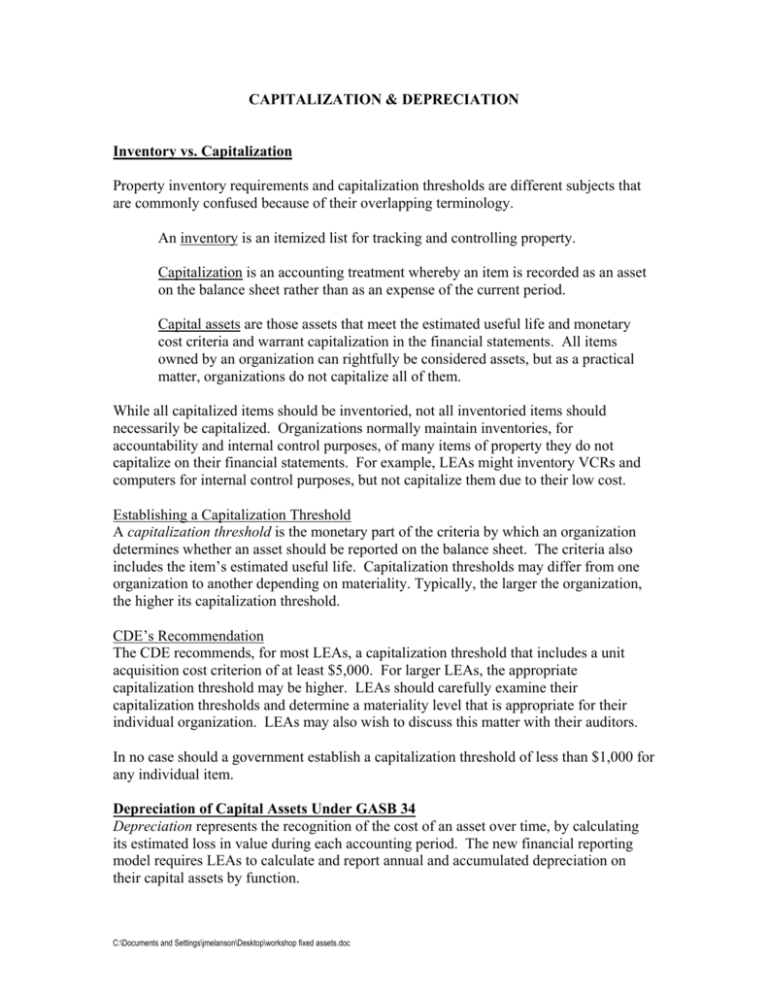CAPITALIZATION & DEPRECIATION Inventory vs. Capitalization
advertisement

CAPITALIZATION & DEPRECIATION Inventory vs. Capitalization Property inventory requirements and capitalization thresholds are different subjects that are commonly confused because of their overlapping terminology. An inventory is an itemized list for tracking and controlling property. Capitalization is an accounting treatment whereby an item is recorded as an asset on the balance sheet rather than as an expense of the current period. Capital assets are those assets that meet the estimated useful life and monetary cost criteria and warrant capitalization in the financial statements. All items owned by an organization can rightfully be considered assets, but as a practical matter, organizations do not capitalize all of them. While all capitalized items should be inventoried, not all inventoried items should necessarily be capitalized. Organizations normally maintain inventories, for accountability and internal control purposes, of many items of property they do not capitalize on their financial statements. For example, LEAs might inventory VCRs and computers for internal control purposes, but not capitalize them due to their low cost. Establishing a Capitalization Threshold A capitalization threshold is the monetary part of the criteria by which an organization determines whether an asset should be reported on the balance sheet. The criteria also includes the item’s estimated useful life. Capitalization thresholds may differ from one organization to another depending on materiality. Typically, the larger the organization, the higher its capitalization threshold. CDE’s Recommendation The CDE recommends, for most LEAs, a capitalization threshold that includes a unit acquisition cost criterion of at least $5,000. For larger LEAs, the appropriate capitalization threshold may be higher. LEAs should carefully examine their capitalization thresholds and determine a materiality level that is appropriate for their individual organization. LEAs may also wish to discuss this matter with their auditors. In no case should a government establish a capitalization threshold of less than $1,000 for any individual item. Depreciation of Capital Assets Under GASB 34 Depreciation represents the recognition of the cost of an asset over time, by calculating its estimated loss in value during each accounting period. The new financial reporting model requires LEAs to calculate and report annual and accumulated depreciation on their capital assets by function. C:\Documents and Settings\jmelanson\Desktop\workshop fixed assets.doc Depreciation A depreciation schedule, which tracks historical cost and accumulated depreciation, is required for fixed assets. Fixed assets subject to depreciation for most districts will be site improvements, buildings and building improvements, and equipment with a historical cost of $5,000 or more. Current Depreciation = original cost ÷ useful life Accumulated Depreciation = (original cost ÷ useful life) * age Net Book Value (NBV) = Original Cost less Accumulated Depreciation Work In Progress (WIP) – a capital project that has not yet been completed, and is not depreciable until completion To begin the process of developing a depreciation schedule, gather the following information for each asset: 1. Purchase Date: (month & year are sufficient) 2. Asset Description Category: Land/Sites (never depreciates) Site Improvements Buildings Equipment Work In Progress (not depreciated until competed) 3. Historical Cost: The cost of an asset is based on total purchase price, not market value. Total purchase price means the actual cost at the time of acquisition, including any additional sales tax, freight, installation or inspection charges. After obtaining this information, you need to identify: 1. Depreciation Method: CDE recommends the straight-line method as this is the simplest and most straightforward depreciation method. 2. Useful Life: The number of years the asset is expected to be in service. The California State Accounting Manual (CSAM) includes a Table of Estimated Useful Lives which is attached for a general guideline only. The estimated useful life established for each asset is an individual LEA decision and judgment can be used. C:\Documents and Settings\jmelanson\Desktop\workshop fixed assets.doc 3. Depreciation Convention: The convention determines how the depreciation will be calculated for the first year of ownership. We recommend the half-year convention. Assets purchased before January are depreciated for the full year, assets purchased after December are depreciated for one-half the year. Once you have identified the purchase date, cost, depreciation method and useful life you are ready to calculate the accumulated depreciation through June 30. Depreciation Example: School Bus Purchase Date: January 2004 Original Cost = $100,000 Useful Life = 8 years Accumulated depreciation at 6/30/11 = $93,750 2011-2012 Current Depreciation = $6,250 NOTE: If the accumulated depreciation will exceed the asset’s original cost at year end, then Current Depreciation = original cost less accumulated depreciation. See example below: Fiscal Year 2003-2004 2004-2005 2005-2006 2006-2007 2007-2008 2008-2009 2009-2010 2010-2011 2011-2012 Current Depreciation Amount 6,250 12,500 12,500 12,500 12,500 12,500 12,500 12,500 6250 Accumulated Depreciation 6,250 18,750 31,250 43,750 56,250 68,750 81,250 93,750 100,000 Net Book Value (NBV) 93,750 81,250 68,750 56,250 43,750 31,250 18,750 6,250 0 Depreciation by Function GASB 34 dictates that annual depreciation needs to be allocated to functions based on the asset’s use. For instance, the most common method for allocating building depreciation is by square footage. In this method, functions are assigned to rooms based on their use. • By calculating the square footage of each room, a percentage for each function can be calculated, and these percentages are then applied to the annual depreciation to get depreciation by function. C:\Documents and Settings\jmelanson\Desktop\workshop fixed assets.doc






